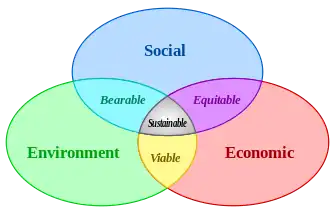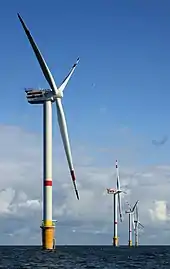 | |
| Formation | 2006 |
|---|---|
| Type | Non-governmental organisation |
| Legal status | Charitable Trust |
| Headquarters | Mumbai |
Region served | India |
President of Foundation | Sumaira Abdulali |
| Website | www |
Awaaz Foundation (meaning "the organisation against sound" – "Awaaz" means "sound" in Urdu) is a charitable trust and non-governmental organisation in Mumbai, India which builds awareness, carries out advocacy, and is involved in educational projects to protect the environment and prevent environmental pollution. It has impacted many important decisions by the government and influenced policy making in important environmental matters in India. The beneficiaries of the Foundation are the citizens of India at large.
Awaaz Foundation was founded on 21 February 2006 by Sumaira Abdulali, a well-known environmentalist, who has exposed many scandals of environmental villainy in India at personal risk. The Foundation has filed several public interest litigations, including demands for strict implementation of noise pollution laws,[1] better functioning of Mumbai's Tree Authority,[2] reducing noise pollution, banning sale of tobacco to minors,[3] efforts to counter the politically sponsored sand mining mafia[4][5][6] and recognition of the biodiverse Sawantwadi-Dodamarg wildlife corridor as an ecologically sensitive area.[7]
Noise pollution
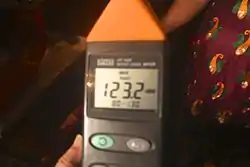
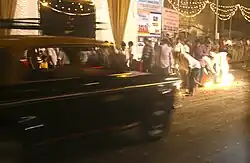

Noise pollution is a serious health hazard and can cause annoyance and aggression, hypertension, high stress levels, tinnitus, hearing loss, sleep disturbances, heart disease, mental illness and other serious effects on health. Like smoking, noise pollution affects active and passive recipients when noise levels cross certain safe boundaries.[8][9][10] Anti-Social behaviour such as public use of firecrackers and Loudspeakers[11][12] is a highly sensitive social issue[13][14][15] in India.[16][17] Among the major forms of pollution in India is noise pollution. There is no parallel in the world to the noise pollution generated during festivals and religious celebrations in India.[18][19][20] For Indians, making noise is a sign of happiness. For politicians the ability to make a big noise, by using huge loudspeakers at any opportunity, is a sign of strength. Festivals in India have become political battlegrounds as politicians try to score brownie points over one another by attempting to host the noisiest festival.[21] The use of loudspeakers, permitted by the courts on certain occasions, often exceeds the permissible decibel limit, causing a great deal of stress and anxiety to the neighbourhoods.[22]
Awaaz Foundation has advocated against noise pollution from various sources and has conducted campaigns to create awareness of adverse health effects from noise in a methodical and scientific manner.[23][24][25] The various noise pollution campaigns of the Foundation have received widespread public support and turned into a public movement in Mumbai followed by the rest of the country. Increased awareness and vigilance of citizens has resulted in policy change, better systems and better implementation of Noise Rules.[26][27][28]
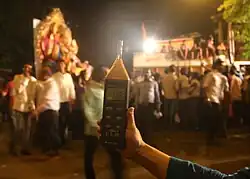
Awaaz Foundation systematically collected noise pollution data for the first time in India, collated and presented it to the State and Union Governments, Courts, police and citizens. Data was generated of noise levels at major events since 2003, from sources including firecrackers, traffic, loudspeakers, industrial equipment and construction.[29]
In 2010 Awaaz Foundation tested noise levels of helicopters after several leading Industrialists applied for permission to build private helipads atop their residential buildings in densely populated areas of Mumbai. After the data was presented in court. permission to use private helipads in all urban areas of India were banned by the MoEF.[30]
Also based on data presented to MoEF during the pendency of the public interest litigation in the Bombay High Court, Government of India's Ministry of Environment and Forests accepted all recommendations by Awaaz Foundation on 11 January 2010 for stricter noise laws in the country and issued a new notification to ban use of loudspeakers, musical instruments and honking in the areas demarcated as silence zones, including areas around religious places throughout India.[31] The MoEF denied permission to the State Government of Maharashtra to permit private helipads for personal use of individuals atop residential buildings and included other sources of noise such as traffic and construction noise within the ambit of the Rules for the first time.[32]
Awaaz foundation filed a Public Interest Litigation on 12 November 2007 in Mumbai High Court[33] seeking implementation of Noise Pollution Rules, 2000, which contemplate creation of silence zones around educational places, courts, hospitals and religious places also.
In 2009 the Bombay High Court accepted the need for implementation of stricter noise laws and ordered the State Government to implement Noise Pollution regulation rules notified by 'Central Pollution board', (one of the Subordinate and statutory bodies) of Government of India's Ministry of Environment and Forests. Consequent to the Bombay High Court Order, the State Government of Maharashtra initially notified and asked municipal bodies in the state to demarcate an area of 100 metres (330 ft) around educational institutions, hospitals and courts as silence zones but left out the areas surrounding religious places as silence zones. Awaaz Foundation once again petitioned the Court to have these places notified as silence zones.[34] On 6 August 2009, the principal secretary of the Home Department, Government of Maharashtra in an affidavit told the court that about 1,313 religious places had been identified in the city of Mumbai and the BMC would put up Silence zone boards within three months.

Finally on 20 Aug 2009 principal secretary (appeals and security) Government of Maharashtra Mr. Anna Dani filed an affidavit stating that a supplementary notification has been issued to include all religious places in silence zone, and has been circulated to all civic bodies in the state.[35]
Awaaz Foundation's advocacy against noise pollution in India motivated the Government of India to make rules and implement them. Awaaz Foundation has successfully petitioned both local and state governments in India to impose stricter noise pollution laws. Under the Environment Protection Act, in which the new Noise Pollution Rules are framed, violation of the rules is punishable with a Jail term of up to five years and fine of ₹100,000 (US$1,300).[36][37][38][39][40][41][42][43]
Firecrackers, initially used mainly during the Diwali Festival, are now used to celebrate almost any occasion including weddings, cricket matches, and festivals of every community. Awaaz Foundation tested the noise levels of firecrackers along with the Maharashtra Pollution Control Board in 2008, 2010, 2012 and 2013.[44] The noise level of almost all crackers exceeded 100 dB and some varieties consistently exceeded 125 dB. Firecracker packaging did not disclose details of noise levels or chemical content or even the year of manufacture; the Petroleum and Explosives Safety Organisation (PESO) who is the Authority to check firecrackers at the stage of manufacture and the Arms and Explosives Department of the Mumbai Police who license firecracker vendors did not take action for many years following complaints of violations. In 2012, Awaaz Foundation, under Right to Information, obtained an Order to disclose details of all firecrackers tested by PESO on their website. Diwali 2012 was the quietest Diwali in recent years[45][46][47][48] In 2013. the Mumbai Police undertook an awareness and enforcement campaign for the 10pm deadline on bursting crackers during the Diwali Festival. The Firecracker Distributors' Association of Mumbai and Thane also cooperated in this effort. Diwali 2013 was the quietest in a decade.[49][50]
Awaaz Foundation also has organised volunteers groups, offered them support and education to all those who faced noise related problems, independently monitored Ambient noise level using sound level meter.[51] and interacted with the authorities to ensure their support and co operation.[52] Excessive noise from loudspeakers,[53] construction,[29] traffic[54] and firecrackers[55][56] have been separately taken up by Foundation at various times and with various authorities; educational programs and publications for schools, colleges, citizens groups and the authorities empowered to implement the laws have been supported and implemented.[57]
Awaaz Foundation encouraged citizen participation to implement noise rules by creating awareness about a free downloadable application onto phones to measure decibel levels. Awaaz requested citizens to complain to the Mumbai Police website with a copy to them for followup and received numerous complaints in the festival season 2012.[58] In 2013, Awaaz Foundation used newly available technology called Noise Watch, a free App to use smartphones or iPhones as decibel meters to build a participatory citizens campaign to map noise levels across Mumbai. A Facebook page Citizens' Noise Map supports the initiative and the readings taken by citizens are upload able directly onto a GIS map. The initiative caught on quickly during Ganpati 2013 and spread to other Indian cities such as Pune almost immediately. The citizens' noise map was sent to the Chief Minister of Maharashtra and spurred a decision of the Government to conduct a formal noise map of Mumbai.[59][60][61]
Awaaz Foundation has conducted numerous awareness campaigns including #GetWellSoonMumbai, a social media campaign on Facebook, #TellTheDriver not to honk in partnership with the Thane, Navi Mumbai and Mumbai Traffic Police, #HornFllu in partnership with the Indian Medical Association, Noise Annoys in partnership with the Times of India #YourAwaazAgainstNoise, #GodsAgainstNoise.[62] In 2015, community leaders carried out awareness drives to reduce noise from Mahim Fair and Eid e Milan through public Statements and grass root level campaigns[63]
Awaaz Foundation measured noise at the Shiv Sena Party's annual Dasara Rally in 2010, 2011, 2012 2013, 2014 and 2015 and presented their findings to the Police and Bombay High Court. Based on these readings the police filed cases against Rally organizers.[64][65][66]
Following final hearings of Awaaz Foundation's PIL, clubbed with nine other PILs by the Bombay High Court in August 2016, a comprehensive final Order was passed. For the first time, noise levels during the Ganpati festival declined in 2016[67][68] Noise levels declined again during Diwali 2016. Mumbai, which in January 2016 was named the noisiest city in India by the Central Pollution Control Board was the only city to see decline in noise levels during the Diwali Festival. The Mumbai Police issued a Statement thanking citizens of Mumbai for making noise pollution reduction a citizens' movement.[69][70]
Sand Mining

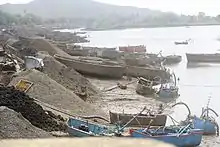

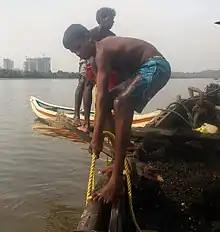
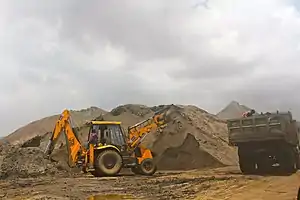
Awaaz Foundation has also worked to conserve the coastal ecosystems and aquatic ecosystem habitats, and has engaged in marine conservation activism against nonessential seabed mining. Sand mining is a practice that is becoming an environmental issue in many countries. Awaaz Foundation has raised public awareness of illegal sand mining in Maharashtra and Goa States of India.
Illegal sand mining is a major unacknowledged threat to coastal and riverine biodiversity in India. The suspension of Indian Administrative Service officer Durga Shakti Nagpal for allegedly acting against illegal sand mining in Noida UP has brought the issue, which is rampant all across the country, into sharp focus.[71]
Sand mining is a little known threat to biodiversity, water security and prime coastal or riverside land all over the world and is capable of causing land erosion, contaminating sweet water along coastlines and rivers, and destroying entire habitats in a very short space of time. While there are numerous scientific studies on habitat degradation for various other reasons, and specific studies on loss of various species of flora and fauna, there is no official information available on the effect on entire ecosystems due to large scale illegal sand mining, particularly coastal sand mining. The issue was brought to attention at any national or international forum for the first time through a side event The effect of coastal sand mining on biodiversity at the Convention on Biological Diversity Conference of Parties 11 by Awaaz Foundation and Bombay Natural History Society(BNHS) in October 2012. In August 2013, the National Green Tribunal banned sand mining in rivers across India.[72] However, illegal sand mining on the coast around Mumbai continued even after the Order.[73]
The term sand mafia has been referred to by the Indian media while referring to those supporting or engaged in illegal sand mining (mainly politicians) who threaten, attack and kill Government and Police officers, activists or any other person who attempts to stop the illegal activity.[74] MITRA (Movement against Intimidation, Threat and Revenge against Activists), a network of NGOs to protect activists in Maharashtra was set up after an attack by the sand mafia on Awaaz Foundation Convenor Sumaira Abdulali in 2004.[75] This was the first publicly reported attack by the sand mafia but over the years there have been numerous others including a second attack on Sumaira Abdulali and a team of journalists, the murder of a Police Officer in Madhya Pradesh, murder of activists in Tamil Nadu and UP, and the suspension of IAS Durga Shakti Nagpal.[76] Awaaz Foundation wrote to the Prime Minister of India protesting Durga Nagpal's transfer and demanded an investigation into the links between the transfer, the murder of activist Pale Ram Chauhan in the same area a few days later, and the politically led sand mafia of the region. An investigation was conducted by the MoEF and the presence of the sand mafia was confirmed. Report of MoEF on sand mining[77][78][79]
The State Government of Maharashtra first took serious note of illegal coastal sand mining in 2004 following an incident of assault at Kihim Beach on Sumaira Abdulali (Convenor of Awaaz Foundation) by the son and employees of a local Member of the Legislative Assembly who are part of an extensive politically controlled sand mafia in Maharashtra. After that, Awaaz Foundation filed a public interest litigation (PIL) in the Bombay High Court seeking a ban on mining activities along the Konkan coast. Following the PIL, the court banned mining in the CRZ (coastal regulation zone) area and directed that a comprehensive report on alternatives to sand dredging prepared by Indian Institute of Technology Bombay should be implemented by the State Government. The Report includes measures to compulsorily manufacture and use artificial sand from building debris, environmental cess on natural sand and more environmentally friendly techniques of sand dredging.[80][81][82]
Sumaira Abdulali was attacked a second time in March 2010 at Mahad while inspecting a site where illegal sand dredging is rampant.[4] Thereafter, the Bombay High Court has completely banned all sand mining activity in the State of Maharashtra and the Government has been forced to notify a completely new Policy on sand mining after considering the IIT Bombay Report.[83][84]
Sumaira Abdulali of Awaaz foundation raised some specific queries under the Right to Information Act regarding number of licences issued to barges carrying sand from Raigad district to Mumbai and Navi Mumbai along with the name of barges owners, conditions for operations as well as the number of inspections deployed to check if any contraband material was being smuggled into the jetty. The MMB did not respond for several months, then foundation filed these queries with the Maharashtra State Information Commission. Thereafter, the concerned agencies responded that neither The Maharashtra Maritime Board (MMB) nor Directorate-General of Shipping (DGS) nor The Indian Coast Guard maintain any records of the number of barges that move in and out of the inland waters on a day -to -day basis.[85] The new sand mining policy stipulates that the barges should be registered and the list should be updated with the local Tehsildar. The Maharashtra Maritime Board (MMB) will Provide No Objection Certificates to the sand barges that pass through the sea channel after the letters of approval from the district collector.
Awaaz Foundation inspected numerous illegal sand mining sites in the coastal areas near Mumbai including Thane, Vaitarna, Bankot Creeks, Kihim and Awas beaches and sent their findings to the MoEF, Government of Maharashtra, police and local authorities.[86] They were instrumental in bringing public awareness about illegal sand mining and political links to this activity. Awaaz Foundation published a Report ' The links between politicians and sand mining in and around Mumbai.[87] To control illegal sand mining controlled by politicians, Awaaz Foundation has proposed a specially trained environmental police in India.[88]
To advocate policy change and raise awareness internationally, Awaaz Foundation participated and raised awareness for the first time in any national or International Convention through a side event in the Conference of Parties 11 held under the United Nations Convention on Biological Diversity in Hyderabad India in October 2012.[89][90] Awaaz Foundation participated in the making of a documentary film on international coastal sand mining, Sand Wars, directed by Denis Delestrac. Sand Wars had record viewership when shown on the French channel Arte. Awaaz Foundation is advocating inclusion of coastal sand mining on the Agenda of the next Convention of Biodiversity Conference of Parties 12 in 2014 by writing to the Indian Government, who is its International custodian until October 2014.[91]
In 2016, Awaaz Foundation once again represented to the United Nations that the ill effects of sand mining should form part of the global agenda of the United Nations Environment Programme during a meeting with Mr Erik Solheim, chief of UNEP. They also pressed for mainstreaming of alternative methods of building and road construction using recycled debris and plastics, which have been successful in pilot and small projects.[92]
In August 2016 a number of people lost their lives when a bridge was swept away at Mahad. The bridge was located near a sand mining site where Sumaira Abdulali had been attacked in 2010 during a sand mining site inspection. Sand mining equipment was found abandoned in the creek. Awaaz Foundation demanded an enquiry into the link between the collapse and nearby illegal sand mining, but Home Minister to the Government of Maharashtra Deepak Kesarkar, without carrying out any enquiry, stated that there was no link.[93][94]
Mining in dense forests

In 2006, India applied to the UNESCO MAB for the Western Ghats to be listed as a protected World Heritage Site. The Western Ghats is very important Tropical Rainforest of India. During the monsoon season between June and September, the unbroken Western Ghats chain acts as a barrier to the moisture laden clouds. The range starts near the border of Gujarat and Maharashtra, south of the River Tapti, and runs approximately 1,600 kilometres (990 mi) through the states of Maharashtra, Goa, Karnataka, Tamil Nadu and Kerala ending at Kanyakumari, at the southern tip of India, one of three Biodiversity hotspots in the country.[95]
The National Mineral Policy of India, 2008 rules that any abandoned mine "should be made richer than what it was before" through refilling the craters and reforestation, but most miners leave their mines in a state of utter decay and toxicity. According to the data available with the ministry's Indian Bureau of Mines, there are 297 abandoned mines across the country and most of them are yet to be "rehabilitated". To protect large-scale destruction of flora and fauna around Western Ghats. Awaaz Foundation is advocating a zero-mining policy.[96]
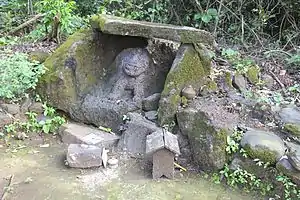
Awaaz Foundation successfully filed public interest litigation to declare the Sawantwadi–Dodamarg wildlife corridor as an eco sensitive area.[97] The State Government of Maharashtra had sanctioned 49 mines in the area,[98] even though its own record shows that the corridor, connecting national parks such as Radhanagari Wildlife Sanctuary in Maharashtra with those in Goa and Karnataka, abounds in indigenous flora and fauna including tiger and elephant and has the highest green cover in Maharashtra (49%). Sawantwadi-Dodamarg, due to its many natural springs and high rainfall, is also a source area for rivers which feed water to Goa. 22 villages signed resolutions not to allow mines in their area.[99][100]
The ministry of environment and forests of Government of India appointed two high levels Committees to recommend the type of development which should take place in the Western Ghats.[101] Initially, the MoEF appointed the Western Ghat Ecology Expert Panel headed by ecologist Dr. Madhav Gadgil but suppressed its Report which recommended that the entire Western Ghats were eco sensitive to varying degrees.[102] Awaaz Foundation and other concerned citizens filed Right to Information applications which resulted in the Report being made public over 6 months after it was finalised.[103][104] Amid growing demand for implementation of the Western Ghat Ecology Expert Panel, the Government appointed another Committee chaired by Dr. Krishnaswamy Kasturirangan to assess the recommendations of the Western Ghat Ecology Expert Panel Report.[105][106] Dr. Kasturirangan Report too, was neither accepted nor declined for several months.
Meanwhile, Awaaz Foundation's litigation for declaration of the Sawantwadi-Dodamarg wildlife corridor as eco sensitive was heard by the Bombay High Court on 28 September 2013 and the Government ordered to notify it as eco sensitive before 31 December 2013.[107][108] The Order was passed during the pendancy of both high level Committee Reports and forms a precedent for citizens/villagers to take up smaller bio diverse areas for protection.[109]
Heavy Metal Pollution
Awaaz Foundation measured heavy metal content of firecrackers[110][111] and Holi colours[112] and found high levels of toxic heavy metals in both. Tests conducted by Volunteer Faiz Abdulali using a sensitive meter capable of detecting specific heavy metals instantly through surface contact was used. In 2013, metals which are banned under the Manufacture, Storage and Import of Hazardous Chemicals Rules 1989 and placed under Schedule 1 for their highly toxic nature through ingestion or through contact were detected such as Vanadium, Copper, Zirconium, Lead and other heavy metals. These were found specially in commonly used crackers such as sparklers which are often handled by children. Awaaz Foundation has demanded a full disclosure of all chemical content of firecrackers on their packaging. This would be in accordance with Supreme Court Orders.[113][114]
See also
- noise regulation scale
- Sound level meter
- Environmental Principles and Policies
- Environmental design and planning
- Noise health effects
- Loud music
- Noise-induced hearing loss
- Loudness
- Environmental Policy
- Environmentalism
- Human ecology
- Environmental movement
- Forest protection
- List of environmental issues
- Environmental design
- Environmental agreements
References
- ↑ Lakshmi, Rama (10 October 2013). "Sumaira Abdulali fights to lower noise levels in Mumbai, India's capital of noise". The Washington Post. Archived from the original on 15 October 2013.
- ↑ "Banning tobacco sale near schools". cigarettesreviews.com. 10 July 2009. Retrieved 20 October 2010.
- 1 2 Viju B (17 March 2010). "Sand mafia attacks TOI team in Raigad". The Times of India. Retrieved 20 October 2010.
- ↑ "How sand mining mafia is plundering beaches, creeks". Khaleej Times, Dubai, United Arab Emirates. Archived from the original on 22 March 2012. Retrieved 16 October 2010.
- ↑ "Revenge attacks". hinduonnet.com. Archived from the original on 29 August 2010. Retrieved 20 October 2010.
{{cite web}}: CS1 maint: unfit URL (link) - ↑ "'Declare Sawantwadi corridor ecologically sensitive by Dec'". Indian Express News Service. 28 September 2013. Retrieved 13 June 2020.
- ↑ "Is all this noise pollution in Mumbai hazardous for you?". www.mid-day.com.
- ↑ Rao, Prahlad (23 February 2010). "Make some noise about sound pollution too". Bangalore: DNA. Retrieved 29 December 2010.
- ↑ "World Health organization- Noise". Archived from the original on 14 October 2010. Retrieved 16 October 2010.
- ↑ NDTV Correspondents (20 October 2010). "Police case against Shiv Sena for noise pollution". NDTV. Archived from the original on 23 October 2010. Retrieved 20 October 2010.
- ↑ Press Trust of India (20 October 2010). "Noisy Shiv Sena wants action against loudspeakers atop mosques". Hindustan Times. Mumbai. Archived from the original on 21 October 2010. Retrieved 20 October 2010.
- ↑ Express News Service (21 October 2010). "Under fire for noise, Sena says ban masjid mikes too". Mumbai- India: Indian Express News Service. Retrieved 21 October 2010.
- ↑ PTI (20 October 2010). "What about loudspeakers atop mosques, asks Shiv Sena". Daily news and analysis. Mumbai- India. Archived from the original on 23 October 2010. Retrieved 20 October 2010.
- ↑ Kaushik, Nitya (20 October 2009). "High-decibel Diwali brought to CM's notice". The Indian Express. Mumbai. Retrieved 17 October 2010.
- ↑ Aaj Tak (20 October 2010). "मुंबई: शिवसेना के रैली आयोजकों के खिलाफ दूसरा केस दर्ज हुआ" (in Hindi). Aaj Tak (IndiaToday Group). Archived from the original on 21 October 2010. Retrieved 20 October 2010.
- ↑
Manuel, Roshni (31 March 2009). "Combating noise pollution". legal service india.com. Retrieved 16 October 2010.
{{cite journal}}: Cite journal requires|journal=(help) - ↑ Legal, Our (20 October 2010). "Judge call for noise-norm vigil". The Telegraph. Kolkata. Archived from the original on 24 October 2010. Retrieved 21 October 2010.
- ↑ Deshmukh, Chaitraly (23 September 2010). "Dagduseth mandal in trouble for breaching noise norms, Belbaug witnesses tense moments after a few mandals obstruct procession, after police allowed Dagdusheth Halwai Ganpati Mandal to violate noise norms". Pune Mirror. Pune. Archived from the original on 18 July 2011. Retrieved 21 October 2010.
- ↑ Express News Service (24 September 2010). "Noise norms violated, cases against mandals". Pune: Indian Express News Service. Archived from the original on 10 October 2012. Retrieved 21 October 2010.
- ↑ "गणेशोत्सवात डॉल्बीवर बंदी घालू नये" (in Marathi). Kolhapur: esakal. 29 August 2010. Archived from the original on 20 January 2011. Retrieved 28 December 2010.
- ↑ Blakely, Rhys (14 March 2009). "Zones of silence bring permanent hush hour to Mumbai". London: Times Newspapers London. Retrieved 17 October 2010.
- ↑ "The anti- noise pollution campaign in India". Archived from the original on 2 December 2013. Retrieved 2013-09-29.
- ↑ "Sumaira Abdulali | Outlook India Magazine".
- ↑ Patel, Mitali (3 January 2008). "Mitali Patel reports on the efforts of Awaaz, which is campaigning against noise pollution". Moneylife Personal Finance Magazine. Retrieved 17 October 2010.
- ↑ "डॉल्बीच्या दणदणाटाबद्दल सहा मंडळांवर गुन्हे दाखल" (in Marathi). Kolhapur: esakal. 28 December 2010. Archived from the original on 23 January 2011. Retrieved 28 December 2010.
- ↑ Rachana Nakra (14 August 2009). "Freedom from noise – Sumaira Abdulali". livemint.com, Wall Street Journal. Retrieved 9 July 2013.
- ↑ ANI (30 October 2010). "Katy Perry-Russell Brand wedding: FIR against resort for noise pollution". Daily news and analysis. Jaipur India. Archived from the original on 1 November 2010. Retrieved 30 October 2010.
- 1 2 "Construction causes more noise than festival speakers". The Times of India. 5 June 2013. Archived from the original on 3 July 2013.
- ↑ "Hindustan Times – Archive News". Archived from the original on 13 March 2014.
- ↑ "Ministry of Environment and Forests Notification" (PDF) (in Hindi and English). New Delhi: Government of India. 9 March 2009. Retrieved 21 October 2010.
- ↑ IANS (6 July 2010). "No private helipads in country: Jairam Ramesh". The Times of India. New Delhi. Archived from the original on 9 July 2010. Retrieved 25 October 2010.
- ↑ "PIL No 85 of 2007 and affidavits In Mumbai High Court". Awaaz Foundation. Archived from the original on 25 July 2011. Retrieved 24 October 2010.
- ↑ Thomas, Shibu (21 August 2009). "Religious places within silence zone ambit: Govt". The Times of India. Mumbai. Retrieved 17 October 2010.
- ↑ "Affidavit of State Government of Maharashtra – THURSDAY 20 AUGUST 2009". Awaaz Foundation. Archived from the original on 25 July 2011. Retrieved 24 October 2010.
- ↑ "Shiv Sena in trouble over Dussehra rally". Hindustan Times. Mumbai. Indo-Asian News Service. 20 October 2010. Archived from the original on 25 January 2013. Retrieved 20 October 2010.
- ↑ "आठ डॉल्बी मालक, मंडळांना साडेपाच हजारांचा दंड" (in Marathi). Kolhapur: Lokmat Newspapers. 15 September 2010. Archived from the original on 23 August 2011. Retrieved 28 December 2010.
- ↑ Press Trust of India (20 October 2010). "Court nod for inquiry against Shiv Sena men under environment act". Daily News and Analysis. Mumbai. Retrieved 20 October 2010.
- ↑ "Court to hear Shiv Sena noise pollution case". Sify News. Mumbai. 19 October 2010. Archived from the original on 11 August 2011. Retrieved 19 October 2010.
- ↑ Raghunath, Pamela (19 October 2010). "Police registered a complaint under the Environment Act against Shiv Sena". Gulf News. Mumbai. Archived from the original on 23 October 2010. Retrieved 19 October 2010.
- ↑ "Police lodge complaint on Sena rally noise, say peaked at nearly twice prescribed limit". Mumbai: Indian Express News Service. 19 October 2010. Retrieved 19 October 2010.
- ↑ Headlines Today Bureau (18 October 2010). "Case against Sena over noise level at Mumbai rally". India Today. Mumbai- India. Archived from the original on 20 October 2010. Retrieved 19 October 2010.
- ↑ "State asks collectors to enforce noise pollution norms". Business Standard. Kolkata/ Bhubaneswar. 9 April 2010. Retrieved 21 October 2010.
- ↑ "Noisy Diwali ahead as tests reveal most crackers violate decibel limits". The Times of India. 15 October 2013. Archived from the original on 16 October 2013.
- ↑ "- Noise levels of crackers to be put on the web-site". RTI Foundation of India.
- ↑ "Noise levels of crackers to be put on the web-site – RTI Foundation of India". www.rtifoundationofindia.com.
- ↑ "City braces itself for 'noisy' Diwali | The Asian Age". The Asian Age. Retrieved 19 August 2023.
- ↑ "News18.com: CNN-News18 Breaking News India, Latest News Headlines, Live News Updates". News18. Archived from the original on 16 November 2012.
- ↑ "Cops to enforce 10pm deadline for firecrackers". The Times of India. 2 November 2013. Archived from the original on 7 November 2013.
- ↑ "Kudos to citizens for a less noisy Diwali this year". The Times of India. 4 November 2013. Archived from the original on 7 November 2013.
- ↑ Rebello, Snehal (24 September 2010). "Bhandup was noisiest, Juhu surprisingly silent". Hindustan Times. Mumbai. Archived from the original on 25 January 2013. Retrieved 17 October 2010.
- ↑ PTI (17 October 2010). "Mumbai police to keep a close watch on Shiv Sena's Dussehra rally". Daily news and analysis. Mumbai. Retrieved 17 October 2010.
- ↑ PTI (20 August 2009). "Religious places to be declared as silence zones". Daily news and analysis. India. Retrieved 17 October 2010.
- ↑ "Traffic Noise in Mumbai". Awaaz Foundation. Archived from the original on 6 December 2013.
- ↑ Shivadekar, Sanjeev (17 October 2010). "Cops, BMC to enforce ban on crackers". The Times of India. Retrieved 20 October 2010.
- ↑ Aghor, Ashwin (13 October 2008). "Cops have cracker of an idea". Daily news and analysis. Mumbai. Retrieved 17 October 2010.
- ↑ "Now, check noise level with new app". The Times of India. 21 October 2012. Archived from the original on 3 January 2013.
- ↑ "Now, MMRDA to map noise levels". The Times of India. 14 September 2013. Archived from the original on 28 September 2013.
- ↑ "Use new phone app to check noise levels in your area and post it on FB – Indian Express". www.indianexpress.com. 11 September 2013.
- ↑ "Citizens' noise map indicates 18 danger zones – The Times of India". The Times of India.
- ↑ "The Campaign to Quiet India's Loud Festival Season". Bloomberg.com. 8 September 2016.
- ↑ "Noise levels at Mahim Fair higher than Eid processions, says NGO – Times of India". The Times of India. 26 December 2015.
- ↑ "Noise levels during Shiv Sena Dussehra rally reached a crescendo: Awaaz foundation". The Times of India. 26 October 2012. Archived from the original on 3 January 2013.
- ↑ "Processions make Sena rally noisier this year". The Times of India. 14 October 2013. Archived from the original on 17 October 2013.
- ↑ "Sena gets notice for Dussehra rally". The Times of India. 16 October 2013. Archived from the original on 17 October 2013.
- ↑ "Ganeshotsav: Opera House noisiest for 2nd year in a row; mandals cross deadline". 16 September 2016.
- ↑ "Mumbai Samachar is under construction". www.mumbaisamachar.in.
- ↑ "2016 was an important year for anti-noise movement in Mumbai, says activist". 23 December 2016.
- ↑ "Aware citizens helped bring down noise pollution: Police – Times of India". The Times of India. 8 November 2016.
- ↑ "Let CBI probe Durga's suspension, activists say". The Times of India. 6 August 2013. Archived from the original on 29 September 2013.
- ↑ "Green clearance must for sand mining – DNA – English News & Features – Top News". dnasyndication.com.
- ↑ "Sand-mining banned in Maharashtra but flourishes on Mumbai's outskirts". The Times of India. 9 August 2013. Archived from the original on 9 September 2013.
- ↑ "Downtoearth". www.downtoearth.org.in.
- ↑ "And now, a 'mitra' for whistle-blowers". The Times of India. 21 July 2004. Archived from the original on 2 January 2014.
- ↑ "Now, sand mining mafia attacks government officials in M.P". The Hindu. Chennai, India. 10 March 2012.
- ↑ "A look into the dark and dangerous world of illegal sand mining". India Today.
- ↑ "Awaaz Foundation launches online petition for CBI inquiry". The Times of India. 1 August 2013. Archived from the original on 24 August 2013.
- ↑ "Here's how you can support suspended IAS officer Durga Shakti Nagpal". 2 August 2013.
- ↑ Pillay, Amritha (18 March 2010). "Bombay High Court slams police in Abdulali attack case". Sucheta Dalal .com. Retrieved 25 October 2010.
- ↑ "Environmentalist appeals to save land". gulfnews.com. 16 April 2011. Retrieved 19 August 2023.
- ↑ "Archived copy". Archived from the original on 2 October 2013. Retrieved 29 September 2013.
{{cite web}}: CS1 maint: archived copy as title (link) - ↑ "HC bans sand mining across Maharashtra". The Times of India. Mumbai. 25 September 2010. Retrieved 16 October 2010.
- ↑ Shivadekar, Sanjeev (6 October 2010). "State panel on sand mining has only netas". The Times of India. Mumbai. Retrieved 19 October 2010.
- ↑ Dec, Viju B (5 December 2010). "Coastal agencies have no records of sand barges". The Times of India. Mumbai. Retrieved 6 December 2010.
- ↑ "A sandstorm is coming: Courtesy sand mafia and sand mining". 4 August 2013.
- ↑ "The link between politicians and sand mining in and around Mumbai by Laika Abdulali with Annexures". Archived from the original on 5 December 2013. Retrieved 2013-09-28.
- ↑ "News18.com: CNN-News18 Breaking News India, Latest News Headlines, Live News Updates". News18. Archived from the original on 9 October 2013.
- ↑ "No consensus yet on resource mobilisation". The Times of India. 19 October 2012. Archived from the original on 3 January 2013.
- ↑ "Environmentalists urge alternatives to sand". The Times of India. 12 October 2012. Archived from the original on 3 January 2013.
- ↑ "Illegal sand mining is new gold rush in India". GulfNews. 22 July 2013.
- ↑ "Put sand mining on UNDP agenda: activist". The Hindu. 3 October 2016 – via www.thehindu.com.
- ↑ "Sand mafia free-run abetted Mahad tragedy, say greens". 5 August 2016.
- ↑ "Sand mining not behind Mahad bridge collapse: Maharashtra minister". 8 August 2016.
- ↑ "UNESCO report on Western Ghats (sub cluster nomination)". UNESCO World Heritage Centre. Archived from the original on 4 November 2010. Retrieved 26 October 2010.
- ↑ Viju B (17 October 2010). "Do not allow mining in dense forests, say greens". The Times of India. Retrieved 19 October 2010.
- ↑ "PIL seeks to put an end to mining in green zone". The Times of India. 4 May 2011. Archived from the original on 28 September 2013.
- ↑ "Mining blow to Western Ghats". The Times of India. 15 October 2010. Archived from the original on 22 February 2012.
- ↑ http://southasia.oneworld.net/news/mining-sanction-to-steer-india-towards-ecological-ruin#.UkYivhY0Pdk
- ↑ "India: Mining set to conquer unique coastal strip". www.minesandcommunities.org.
- ↑ "Kasturirangan panel bats for prohibitory regime in Western Ghats". 17 April 2013.
- ↑ "NGO writes to MoEF requesting W Ghats report". The Times of India. 19 January 2012. Archived from the original on 28 May 2013.
- ↑ "Downtoearth". www.downtoearth.org.in.
- ↑ "'Make report on Western Ghats public'". The Times of India. 20 May 2012. Archived from the original on 28 September 2013.
- ↑ "MUMBAI CITY [PG 9] : Greens see red over new Ghat panel". epaper.dnaindia.com.
- ↑ "Why re-examine the Gadgil Committee report on Western Ghats?". Moneylife NEWS & VIEWS. Retrieved 19 August 2023.
- ↑ "'Declare Sawantwadi corridor ecologically sensitive by Dec' – Indian Express". www.indianexpress.com. 28 September 2013.
- ↑ "Declare wildlife corridor as an eco-sensitive area, HC says – The Times of India". The Times of India.
- ↑ "The real gap between two Western Ghats | Jay Mazoomdaar". Archived from the original on 24 July 2013. Retrieved 28 September 2013.
- ↑ "Report on Heavy Metal Content of Firecrackers". Archived from the original on 29 October 2013. Retrieved 9 July 2013.
- ↑ "Breathless during Diwali? Blame it on smoke from sparklers". The Times of India. 13 November 2012. Archived from the original on 29 October 2013.
- ↑ "Tests reveal heavy metal content in Holi colours". Indian Express. 28 February 2010.
- ↑ "Banned heavy metals in crackers even more hazardous than noise". The Times of India. 23 October 2013. Archived from the original on 29 October 2013.
- ↑ "NGO seeks crackdown on dangerous cracker sale". 23 October 2013.
External links
- Noise Pollution Rules in India
- Awaaz Foundation Website
- History of the Noise Pollution Campaign in India
- Citizens' Noise Map
- WHO Report on Community Noise
- European Union Noise Policy
- Noise Mapping UK
- Noise Pollution: Sources, Effects and Control
- WHO Commission on Social Determinants of Health – final report
- The International Institute for Noise control
- Side event on sand mining UN Convention on Biological Diversity
- Sand Wars- documentary film by Denis Delestrac
- Report of MoEF on sand mining
- Coastal Care Website
- Kiwis Against Seabed Mining Archived 2 October 2008 at the Wayback Machine
- The link between politicians and sand mining in and around Mumbai
- Unesco World Heritage Site - Western Ghats of India
